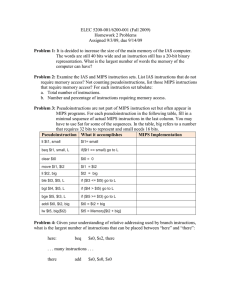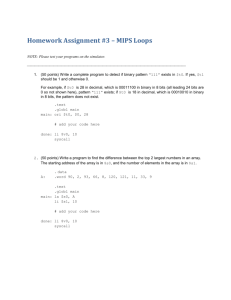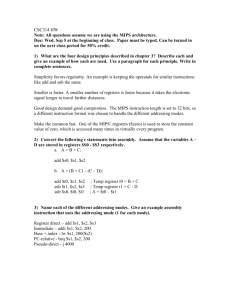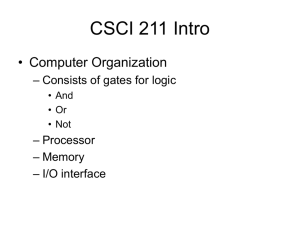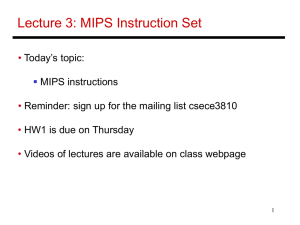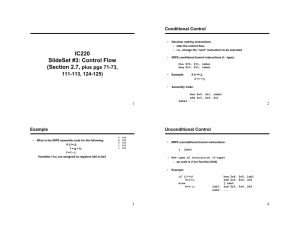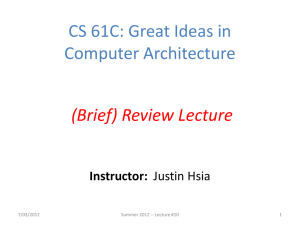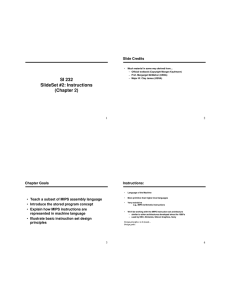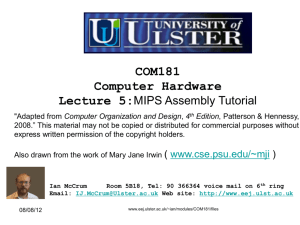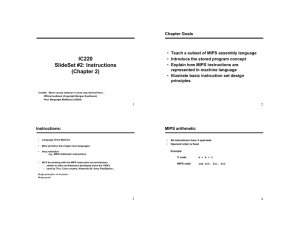Lecture-09
advertisement
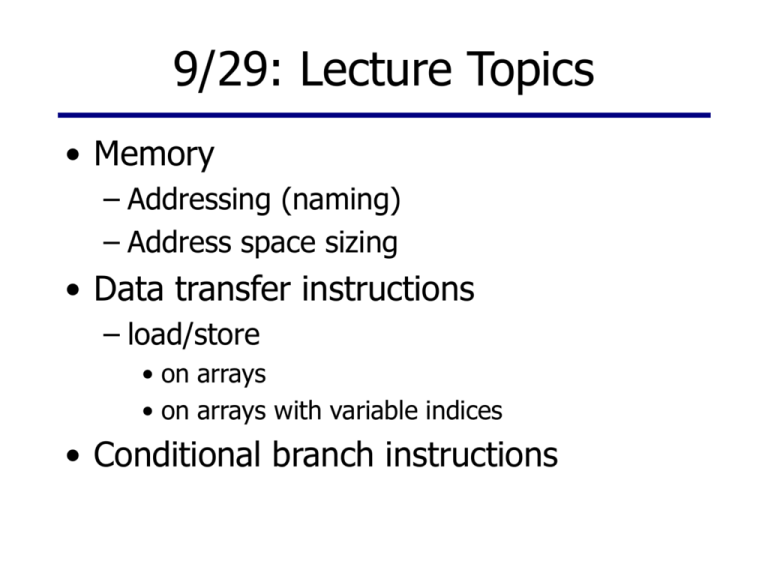
9/29: Lecture Topics
• Memory
– Addressing (naming)
– Address space sizing
• Data transfer instructions
– load/store
• on arrays
• on arrays with variable indices
• Conditional branch instructions
Administrative notes
•
•
•
•
Don’t forget: homework due Monday
Readings: before or after lecture?
Lecture slides on the web/printing
Are you on the mailing list yet?
Memory and Addressing
• Only so many registers, but memory
holds millions of data elements
• Think of memory as a big array
Address
Each address is
a 32-bit number
describing a
location...
Data
0
01011010
1
10011001
2
10001111
3
11110010
4
00011001
...and each data
element is 8 bits
of information.
MIPS Information Units
• Data types and size:
– byte (eight bits)
– half-word (two bytes)
– word (four bytes)
– float (four bytes, single precision)
– double (eight bytes, double precision)
• Memory is byte addressable
• Data types start at an address divisible
by the data type size (alignment)
Word Alignment
Address
Data
0
4
8
12
16
• Why do you think so many architectures
use alignment?
How Big Can Memory Be?
• How big is an address?
– 32 bits
• How many addresses are there?
– 232 = about 4 billion
• How much data lives at each address?
– 1 byte
• How much memory can this computer
have?
– 4 billion x 1 byte = 4 GB
Some Perspective
• Today’s attitude:
– 32 bits is definitely not enough for long
– We hope 64 bits will be enough for a while
• The attitude a while back:
– 16 bits is enough for all time!
– Who could possibly use up 64K of
memory?
Loads and Stores
• Data transfer instructions let us
– load data from memory to registers
– store data from registers into memory
• In MIPS, all data must be loaded before
use and stored after use
– Load-store architecture
• lw instruction fetches a word
• sw instruction stores a word
Alternatives to Load-Store (p. 191)
• register-register is another name for
load-store (MIPS)
• accumulator architectures had only one
register (EDSAC)
• register-memory architectures allow one
operand to be in memory (IBM 360,
Intel 80386)
• memory-memory architectures allow
both operands to be in memory (DEC
VAX)
Load Syntax
• first argument: where to put the data
• second argument: offset
• third argument: address
Desired result:
Load the word at
the address in $s0
into register $t0
Load the word at
the address in $s0
plus 4 into $t0
MIPS assembly:
lw $t0, 0($s0)
lw $t0, 4($s0)
A Related Concept: move
• lw and sw are for moving data between
memory and registers
• move is for copying data from one
register to another
• common usage: zero a register
move $t0, $0
“Complex” Example Revisited
Desired result:
f = (g + h) - (i + j)
f, g, h, i, j are in registers $s0, $s1, $s2, $s3, $s4,
respectively
MIPS assembly:
add $s0, $s1, $s2
sub $s0, $s0, $s3
sub $s0, $s0, $s4
“Complex” Example with L/S
Desired result:
f = (g + h) - (i + j)
load g, h, i, j, compute, then store f
MIPS assembly:
add $s0, $s1, $s2
sub $s0, $s0, $s3
sub $s0, $s0, $s4
Address
Data
200
f
204
208
g
h
212
i
216
j
Arrays in Assembly Programs
• One reason for lw syntax is arrays
– keep the base address in a register
– lw and sw on offsets into the array
• Example:
int A[10];
# addr of A in $t0
A[0] = 0;
sw $0, 0($t0)
A[1] = 0;
sw $0, 4($t0)
Variable Array Indexing
• Very common use of arrays: walk
through the array by incrementing a
variable
• lw and sw instructions allow offset to
be specified:
– as a constant
– as the contents of a register
lw $t0, 4($t2)
vs.
lw $t0, $t1($t2)
Array Example
Idea: translate
g = h + A[i]
into assembly, assuming
Base address of A is in $s3
g, h, i in $s1, $s2, $s4
Operation Types
• Remember these?
Arithmetic
– add, sub, mult, div
Data Transfer
– lw, sw, lb, sb
• Conditional Branch
– beq, bne
• Unconditional Jump
– j, jr, jal
Conditional Branch
A change of the
flow of control of
the program that
depends on a
condition
...
...
?
no
...
yes
...
Control flow in C
• Conditional branch constructs:
– while, do while loops
– for loops
• Unconditional jump constructs:
– goto
– switch statements
Branching Instructions
• beq
• bne
• other real instructions: b, bgez, bgtz,
more...
• other pseudoinstructions: beqz, bge,
bgt, ble, blt, more...
Pseudoinstructions
• One-to-one mapping between assembly
and machine language not strictly true
• Assembler can do some of the work for
you
• Example: bgt is a real instruction; blt
is a pseudoinstruction
• move is a pseudoinstruction
Labels in MIPS
• MIPS allows text tags
– a name for a place to branch to
loop:
add $t0, $t0, $t0
#
bne $t0, $t1, loop
#
sw
#
$t2, 0($t3)
• Under the covers, the assembler
converts the text tag into an address
Building a while loop in MIPS
Idea: translate
i=0;
while(i<100) {
i++;
}
into assembly.
How about a for loop?
• One answer: translate from for to while,
then use while loop conventions
for(i=0; i<N; i++) {
do_stuff(i);
}
i=0;
while(i<N) {
do_stuff(i);
i++;
}
• This is typically how compilers handle
loops
Example C Program
int array[100];
void main() {
int i;
for(i=0; i<100; i++)
array[i] = i;
}
An Assembly Version
main:
start:
exit:
move $t0, $0
#
la
$t1, array
#
bge
$t0, 100, exit #
sw
$t0, 0($t1)
#
addi $t0, $t0, 1
#
addi $t1, $t1, 4
#
j start
#
j $ra
#
